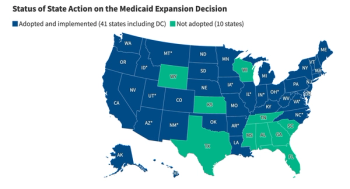
Obesity interventions should include hypertension control
Providers and care teams working to improve the health of overweight and obese patients must keep hypertension detection and management top of mind for this population.
Smallpox, yellow fever, cholera and polio were among major epidemics the United States faced in previous centuries. Since 1990, a new public health epidemic has expanded the waistline of the country: obesity.
Today, one-third of American adults are obese (body mass index of 30 or higher) and an additional third are overweight (BMI of 25.0 to 29.9).
Public health programs and healthcare organizations alike are taking on efforts to curb obesity among youth and adults. This is crucial, as obesity-related conditions include some of the leading causes of preventable death in the United States, such as heart disease, stroke and type 2 diabetes.
Obesity is also a major contributor to one of the biggest underlying causes for heart disease and stroke: hypertension (high blood pressure). The more a patient weighs, the more blood needed to supply oxygen and nutrients to the body’s tissues. As the amount of blood circulating through the blood vessels increases, so does the pressure on artery walls, causing high blood pressure. Hypertension is a public health concern itself, with 68 million patients affected by the disease. Nearly half do not have the condition under control and approximately 20% are not even aware they have it.
Though hypertension is often called the “silent killer” because there are no symptoms that alert the patient or physician that blood pressure is not in control, research shows that body mass index is a key indicator, providing an opportunity for intervention. The seminal
Providers and care teams working to improve the health of overweight and obese patients must keep hypertension detection and management top of mind for this population.
Healthcare executives should consider the following evidence-based care processes to improve hypertension control in their obese population:
- Review training procedures – All team members involved in direct patient care should be re-trained in taking blood pressures according to a standard process. During this training, consider issues that may impact the accuracy of readings for obese patients, including specific education around proper cuff size and an audit of the availability of large and extra-large cuffs in your office.
- Develop patient registries – Effective chronic illness care is virtually impossible without information systems that ensure ready access to key data on individual patients as well as populations of patients. To help providers and care teams focus on patients with both hypertension and obesity, consider developing a patient registry and distributing it on a regular basis to improve treatment.
- Engage specialists – Many obese patients may see specialists for specific care. Ensure all specialty departments routinely take blood pressures on adult patients and refer the not-at-goal patients to primary care. When possible, a primary care appointment should be made before the patient leaves the specialty appointment to reiterate the urgency of this disease.
- Schedule return visits within 30 days – Scheduling follow-up visits within a 30-day window conveys a sense of urgency for the patient. It lets them know that his or her health, and any new or changed medication, is a high priority. Return visits also allow for additional counseling around lifestyle modifications that can reduce both weight and blood pressure numbers, including the DASH Diet and exercise routine recommendations.
- Consider utilizing a health coach – Many medical groups and health systems utilize health coaches to support patients in meeting their specific goals around hypertension, weight and other concerns. If health coaches exist in your organization, consider using a patient registry to identify patients with both hypertension and obesity for additional care.
These evidence-based care processes (“campaign planks”) were developed by the American Medical Group Foundation’s Measure Up/Pressure Down® national hypertension campaign, which brings together nearly 150 medical groups and health systems to achieve a goal of 80% of patients in control of their high blood pressure by 2016. Groups across the nation implement up to eight campaign planks to improve control of their patient populations, which include the obese. In the first year of the campaign, data show more than 205,000 patients have improved detection or control of high blood pressure.
Jerry Penso, MD, MBA is Chief Quality and Medical Officer at the American Medical Group Association. In his role, Dr. Penso oversees quality initiatives through the
Newsletter
Get the latest industry news, event updates, and more from Managed healthcare Executive.





















































